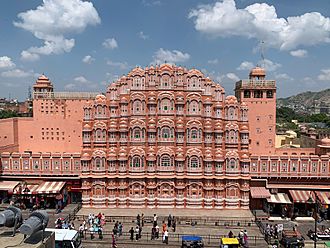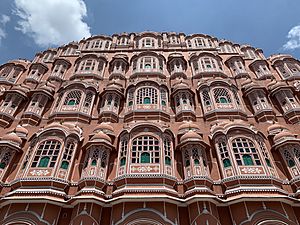Hawa Mahal facts for kids
Quick facts for kids The Hawa Mahal |
|
|---|---|

Eastern façade of the Hawa Mahal, 2022
|
|
| Alternative names | Palace of the Winds, Palace of the Breeze |
| General information | |
| Architectural style | Hindu Rajput Architecture |
| Country | India |
| Coordinates | 26°55′26″N 75°49′36″E / 26.9239°N 75.8267°E |
| Completed | 1799 |
| Technical details | |
| Structural system | Red and pink delivered sandstone |
| Design and construction | |
| Main contractor | Maharaja Sawai Pratap Singh |
The Hawa Mahal is a famous palace in the city of Jaipur, India. It is made from beautiful red and pink sandstone. This amazing building stands right next to the City Palace, Jaipur. It was built so that the royal ladies could have their own special area, called the Zenana.
This unique palace was built in 1799. It was ordered by Maharaja Sawai Pratap Singh. He was the grandson of Maharaja Sawai Jai Singh, who founded the city of Jhunjhunu in Rajasthan. Maharaja Pratap Singh was so impressed by another palace, the Khetri Mahal, that he decided to build this grand Hawa Mahal.
The Hawa Mahal was designed by an architect named Lal Chand Ustad. Its outside looks like a giant honeycomb. It has five floors and 953 small windows. These windows are called Jharokhas and have detailed latticework designs. The main reason for these windows was to let the royal ladies watch daily life and festivals happening on the street below. They could see everything without being seen themselves. These windows also helped cool the palace. They allowed cool air to flow through, making the palace comfortable even on hot summer days. Many people think the side with all the windows is the front of the palace, but it's actually the back!
In 2006, the Hawa Mahal was cleaned up and repaired. This was the first time it had been renovated in 50 years. Some businesses even helped to pay for its upkeep. The palace is part of a much larger complex. Its stone carvings, small windows, and arched roofs make it a very popular place for tourists to visit.
What Makes Hawa Mahal Special?
This palace is shaped like a pyramid and has five stories. It stands about 50 feet (15 meters) tall. The top three floors are quite narrow, like a single room. But the first and second floors have open areas, or patios, in front of them. From the street, the front of the palace looks like a honeycomb. It has many small openings. Each opening has tiny windows, carved sandstone grills, and small domes. This gives the palace its very special look.
The inside of the palace is different. It has rooms with pillars and hallways. The interior used to have rooms with different colored marbles. Some parts were decorated with gold. There were also fountains in the middle of the courtyard.
Lal Chand Ustad was the architect who designed this amazing building. It is made of red and pink sandstone. This color matches many other buildings in Jaipur. That's why Jaipur is often called the "Pink City." The front of the palace has 953 carved windows, called jharokhas. Some of these are even made of wood. This detailed front is very different from the plain back of the building.
The Hawa Mahal shows a mix of two building styles. It combines Hindu Rajput architecture and Islamic Mughal architecture. You can see the Rajput style in the domed roofs, carved pillars, and flower patterns. The Islamic style is seen in the stone designs and arches.
You enter the Hawa Mahal from the City Palace side through a grand door. This door leads into a large courtyard. This courtyard has two-story buildings on three sides. The Hawa Mahal itself forms the fourth side, on the east. There is also a museum in this courtyard.
The Hawa Mahal was a favorite place for Maharaja Jai Singh. He loved its beauty and the way it was built. The small windows on the outside let cool breezes flow through the rooms. This made the palace very comfortable. Fountains in the center of each room also helped to keep the air cool.
You can only reach the top two floors of the Hawa Mahal by ramps, not stairs. The Government of Rajasthan takes care of this historic palace.
Gallery
See also
 In Spanish: Hawa Mahal para niños
In Spanish: Hawa Mahal para niños
- Rajasthan
- Rajput architecture













